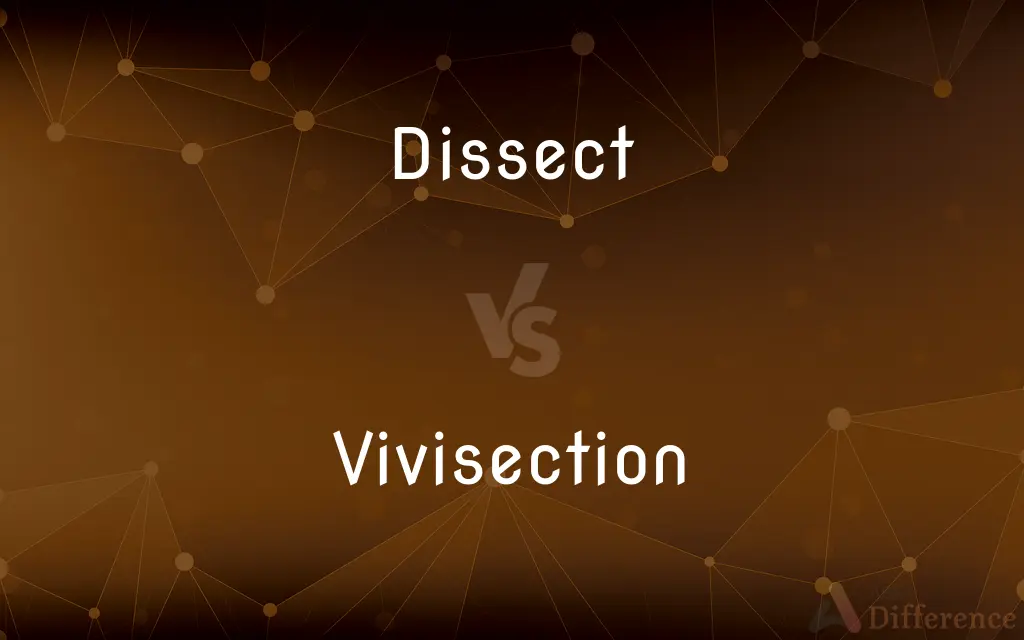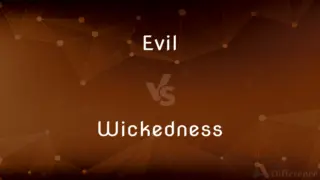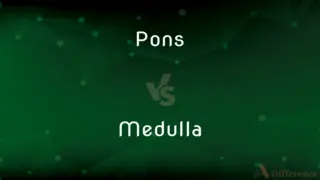Dissect vs. Vivisection — What's the Difference?
By Tayyaba Rehman & Fiza Rafique — Updated on April 28, 2024
"Dissect" refers to cutting open a deceased organism for study, while "vivisection" involves performing surgical procedures on a living organism, typically for scientific research.

Difference Between Dissect and Vivisection
Table of Contents
ADVERTISEMENT
Key Differences
"Dissect" involves the careful cutting apart of deceased organisms to study their structures and internal workings. This practice is fundamental in biological and anatomical studies, enabling researchers to gain insights into the composition and function of various parts. In contrast, "vivisection" is a more controversial procedure that involves performing operations on living organisms, often under anesthesia, to observe physiological processes in real time.
Dissection is commonly used in educational settings, such as in medical or biology classes, where students learn about anatomy through hands-on experience with preserved specimens. Vivisection, however, is typically employed in more complex scientific research, such as in pharmacology or physiology, to study the effects of treatments or understand disease mechanisms in living bodies.
While dissection aims to understand static structures, vivisection seeks to comprehend dynamic biological processes.
Due to ethical concerns, vivisection is heavily regulated and often subject to stringent ethical reviews, whereas dissection of deceased specimens faces fewer ethical hurdles.
Comparison Chart
Definition
Cutting apart deceased organisms for study.
Performing surgery on living organisms for research.
ADVERTISEMENT
Primary Purpose
Study anatomical structures and system organization.
Observe physiological processes in real time.
Usage Context
Education, research on deceased specimens.
Advanced scientific research, often on living animals.
Ethical Considerations
Generally accepted with fewer ethical concerns.
Highly controversial, subject to strict regulations.
Outcome
Provides static anatomical insights.
Yields insights into dynamic biological functions.
Compare with Definitions
Dissect
Used mainly in educational and some research contexts.
Dissecting ancient mummies helps archaeologists study past medical practices.
Vivisection
Surgical operation on a living organism for experimental purposes.
Vivisection is used to study the effects of drugs on heart rate.
Dissect
To cut apart or analyze a deceased organism to study its internal parts.
Students dissect frogs in biology class to understand anatomy.
Vivisection
Often associated with physiological or pharmacological research.
Researchers perform vivisection to observe real-time responses to stimuli.
Dissect
Focuses on static analysis of structure.
Dissecting a flower involves examining its parts under a microscope.
Vivisection
Subject to ethical debate and regulation.
Animal rights groups strongly oppose vivisection due to ethical concerns.
Dissect
Does not involve observation of living processes.
Anatomists dissect brains to understand neurological structures.
Vivisection
Aimed at observing effects under controlled experiments.
Vivisection has been crucial for advancements in surgical techniques.
Dissect
Generally less controversial ethically.
Medical students often dissect cadavers for educational purposes.
Vivisection
Focuses on dynamic biological processes.
Vivisection in labs can reveal how diseases progress in living tissues.
Dissect
To cut apart or separate (tissue), especially for anatomical study.
Vivisection
Vivisection (from Latin vivus 'alive', and sectio 'cutting') is surgery conducted for experimental purposes on a living organism, typically animals with a central nervous system, to view living internal structure. The word is, more broadly, used as a pejorative catch-all term for experimentation on live animals by organizations opposed to animal experimentation, but the term is rarely used by practising scientists.
Dissect
To examine, analyze, or criticize in minute detail
Dissected the plan afterward to learn why it had failed.
Vivisection
The act or practice of cutting into or otherwise injuring living animals for the purpose of scientific research.
Dissect
(transitive) To study an animal's anatomy by cutting it apart; to perform a necropsy or an autopsy.
Vivisection
The action of cutting, surgery or other invasive treatment of a living organism for the purposes of physiological or pathological scientific investigation.
Dissect
(transitive) To study a plant or other organism's anatomy similarly.
Vivisection
The dissection of an animal while alive, for the purpose of making physiological investigations.
Dissect
(transitive) To analyze an idea in detail by separating it into its parts.
Vivisection
The act of operating on living animals (especially in scientific research)
Dissect
To separate muscles, organs, and so on without cutting into them or disrupting their architecture.
Dissect
Of an infection or foreign material, following the fascia separating muscles or other organs.
Dissect
To divide into separate parts; to cut in pieces; to separate and expose the parts of, as an animal or a plant, for examination and to show their structure and relations; to anatomize.
Dissect
To analyze, for the purposes of science or criticism; to divide and examine minutely.
This paragraph . . . I have dissected for a sample.
Dissect
Cut open or cut apart;
Dissect the bodies for analysis
Dissect
Make a mathematical, chemical, or grammatical analysis of; break down into components or essential features;
Analyze a specimen
Analyze a sentence
Analyze a chemical compound
Common Curiosities
How do ethical guidelines affect vivisection?
Ethical guidelines aim to minimize suffering and ensure that vivisection is only performed when absolutely necessary and when no alternatives are available, often requiring rigorous justification and approval processes.
What scientific benefits does vivisection provide?
Vivisection can provide critical insights into how living systems respond to stimuli or treatments, which is invaluable in fields like pharmacology and physiology.
Why is vivisection more controversial than dissection?
Vivisection is more controversial because it involves performing procedures on living organisms, which raises significant ethical concerns regarding the well-being and rights of those organisms.
Are there alternatives to vivisection?
Yes, alternatives include computer simulations, studies on cell cultures, and advanced imaging techniques that do not require invasive procedures on living subjects.
Can dissection be performed on any species?
Yes, dissection can be performed on a wide variety of deceased species, from plants and insects to large animals, as part of educational or research efforts.
Is consent required for dissection of human bodies?
Yes, consent is generally required from the donor before death or from next of kin for the dissection of human bodies, especially in medical and educational contexts.
How has vivisection impacted medical research?
Vivisection has been crucial in developing life-saving treatments and understanding complex disease mechanisms, despite the ethical issues it raises.
What role does public perception play in the debate over vivisection?
Public perception heavily influences the debate over vivisection, with increasing public awareness and concern about animal welfare affecting policies and research practices.
Are there specific laws regulating vivisection?
Yes, many countries have specific laws that regulate vivisection, requiring scientific justification, ethical review board approval, and adherence to strict animal welfare standards.
How do researchers justify the use of vivisection?
Researchers justify vivisection by demonstrating that the potential benefits of the research (e.g., advancements in medicine) outweigh the ethical costs and that no feasible alternatives exist.
Can dissection provide insights into diseases?
Yes, dissection can provide insights into the structural impacts of diseases on organisms, although it cannot replicate the dynamic processes occurring in living organisms.
What are the educational purposes of dissection?
Dissection serves educational purposes by providing hands-on learning about anatomical structures, enhancing understanding of biological function and system organization.
How has technology impacted the practice of vivisection?
Technological advancements have provided alternatives to vivisection, reducing the need for invasive procedures on living animals in some areas of research.
What precautions are taken during vivisection to ensure animal welfare?
Precautions include using anesthesia to minimize pain, providing post-operative care, and implementing refinements to procedures to reduce stress and discomfort.
What ethical considerations are involved in dissection?
Ethical considerations for dissection include respecting the source of the specimen, using specimens responsibly, and ensuring that dissection is performed for legitimate educational or scientific purposes.
Share Your Discovery

Previous Comparison
Evil vs. Wickedness
Next Comparison
Pons vs. MedullaAuthor Spotlight
Written by
Tayyaba RehmanTayyaba Rehman is a distinguished writer, currently serving as a primary contributor to askdifference.com. As a researcher in semantics and etymology, Tayyaba's passion for the complexity of languages and their distinctions has found a perfect home on the platform. Tayyaba delves into the intricacies of language, distinguishing between commonly confused words and phrases, thereby providing clarity for readers worldwide.
Co-written by
Fiza RafiqueFiza Rafique is a skilled content writer at AskDifference.com, where she meticulously refines and enhances written pieces. Drawing from her vast editorial expertise, Fiza ensures clarity, accuracy, and precision in every article. Passionate about language, she continually seeks to elevate the quality of content for readers worldwide.
















































